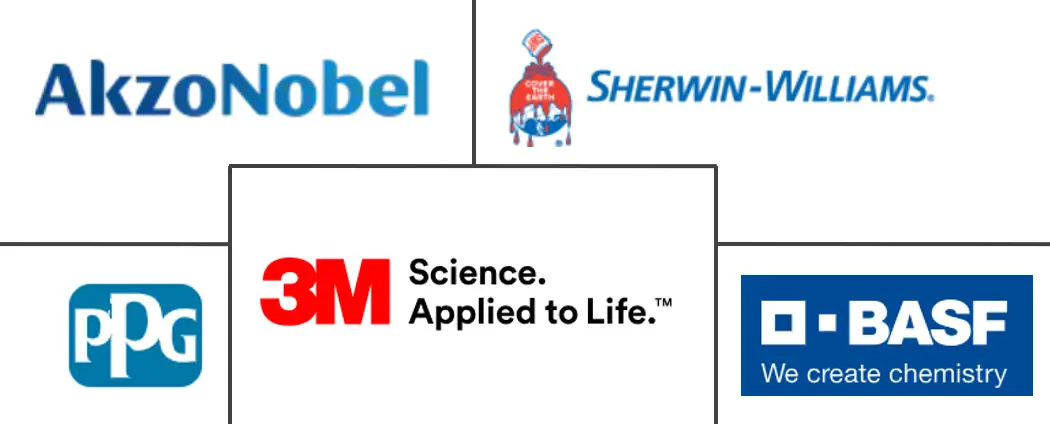Self-Healing Coatings Market Size and Share
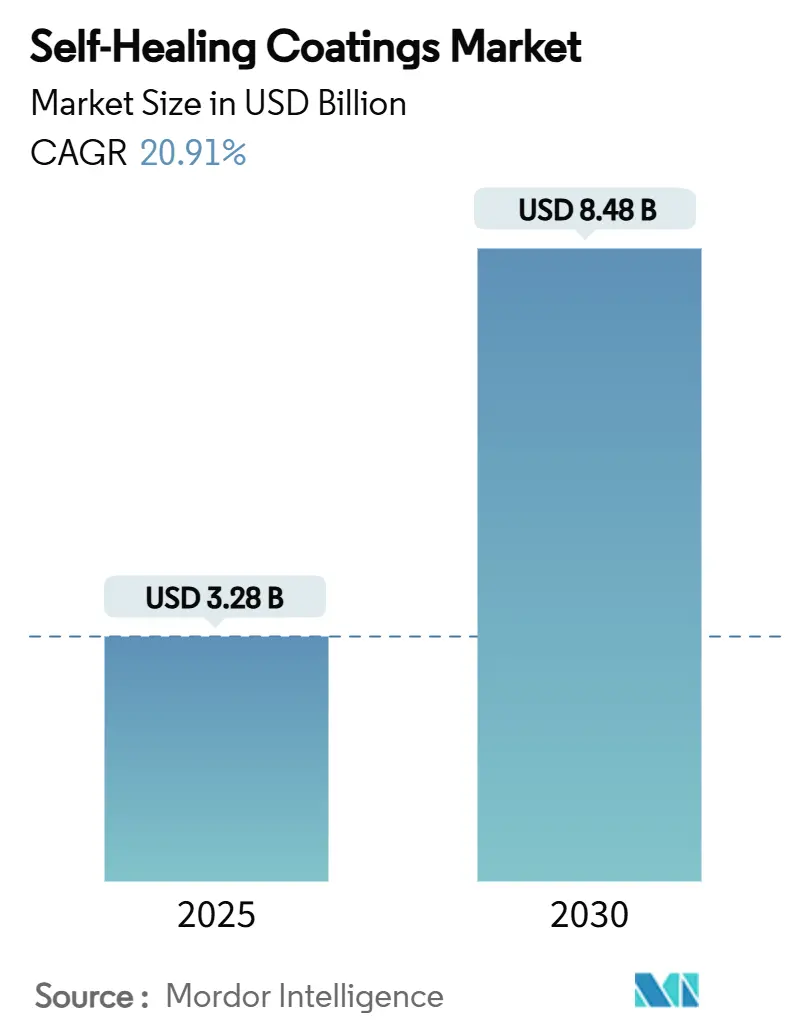
Self-Healing Coatings Market Analysis by Mordor Intelligence
The Self-Healing Coatings Market size is estimated at USD 3.28 billion in 2025, and is expected to reach USD 8.48 billion by 2030, at a CAGR of 20.91% during the forecast period (2025-2030). The steep growth curve arises from rapid micro-encapsulation scale-ups, rising refurbishment demand for aging infrastructure, and stricter corrosion-protection needs across automotive and marine end-users. Europe presently dominates the self-healing coatings market at 48.85% share, propelled by environmental mandates and robust infrastructure renewal programs. Building and construction reflect the imperative of prolonging structural life cycles, yet electrical and electronics are set to outpace all segments in mounting adoption in flexible devices and IoT sensors. Technological maturity, tighter biofouling rules, and OEM pushes for lifetime corrosion warranties collectively position the self-healing coatings market as a transformational enabler of asset longevity across capital-intensive industries.
Key Report Takeaways
- By form, extrinsic systems led with 68.18% of the self-healing coatings market share in 2024; intrinsic systems are forecast to expand at a 21.13% CAGR through 2030.
- By material type, polymers commanded 44.26% share of the self-healing coatings market size in 2024 and are advancing at a 21.38% CAGR through 2030.
- By end-user industry, building and construction contributed 45.71% revenue in 2024, while electrical and electronics is projected to grow fastest at 22.17% CAGR to 2030.
- By geography, Europe accounted for 48.85% of 2024 sales; Asia-Pacific is set to grow at a 24.59% CAGR through 2030.
Global Self-Healing Coatings Market Trends and Insights
Driver Impact Analysis
| Drivers | (~) % Impact on CAGR Forecast | Geographic Relevance | Impact Timeline |
|---|---|---|---|
| Surge in micro-capsule technology scale-up projects | +4.2% | Global, with concentration in North America and Europe | Medium term (2-4 years) |
| Increasing refurbishment demand from aging infrastructure in Asia and Europe | +3.8% | Asia-Pacific and Europe, spill-over to North America | Long term (≥ 4 years) |
| OEM push for lifetime corrosion-warranty in EV platforms | +3.1% | Global, with early gains in China, Germany, United States | Short term (≤ 2 years) |
| Mandatory anti-fouling norms driving marine adoption | +2.7% | Global maritime routes, concentrated in Europe and Asia-Pacific | Medium term (2-4 years) |
| AI-enabled in-situ coating health monitoring unlocking service models | +2.4% | North America and Europe, expanding to Asia-Pacific | Long term (≥ 4 years) |
| Source: Mordor Intelligence | |||
Surge in Micro-Capsule Technology Scale-Up Projects
Industrial-scale micro-encapsulation now achieves healing-agent loading above 80% while safeguarding capsule integrity under high-shear mixing conditions[1]Rajesh Kumar & Anjali Sharma, “Current Challenges in Microcapsule Designs,” National Library of Medicine, pmc.ncbi.nlm.nih.gov. Continuous encapsulation lines have cut unit production costs by roughly 40% since 2024, opening price-sensitive applications without sacrificing performance. BASF and other multinationals are commissioning dedicated facilities that integrate capsule fabrication directly into coating reactors, trimming process steps, and emissions simultaneously. Higher volumes, in turn, fund further chemistry optimization, accelerating a virtuous cost-down cycle that widens the addressable base of the self-healing coatings market. The scale-up momentum also spurs hybrid capsule designs that trigger only under specific pH or stress thresholds, improving material efficiency and extending coating service life.
Increasing Refurbishment Demand from Aging Infrastructure in Asia and Europe
Concrete bridges built during Europe’s post-war era and Asia’s rapid 1990s urbanization are reaching critical deterioration levels where frequent patch repairs are no longer viable. Self-healing crystalline waterproofing additives can autonomously seal micro-cracks, extending service life by 20-30 years and lowering lifecycle costs versus full replacement. Government resilience programs under the EU Green Deal prioritize materials that reduce maintenance-related CO₂ emissions, creating a policy-backed runway for adoption. Parallel infrastructure stimulus in China and India strengthens demand in tunnels, metros, and water-retaining structures, supporting double-digit volume growth for the self-healing coatings market across the region.
OEM Push for Lifetime Corrosion-Warranty in EV Platforms
Electric-vehicle makers aim to align body-in-white corrosion warranties with battery warranties of 10-15 years, shifting coatings specifications from scheduled repainting to lifetime protection. Tesla’s premium models already feature self-healing clear coats that close micro-scratches under mild heat, positioning autonomous repair as a customer-visible differentiator. Battery pack housings face unique galvanic and thermal challenges; self-healing coatings mitigate these risks and support extended warranty promises, justifying premium material spend to automakers. Early adoption in China and Germany is expected to ripple across global EV supply chains, contributing meaningful volume to the self-healing coatings market over the next two years.
Mandatory Anti-Fouling Norms Driving Marine Adoption
The International Maritime Organization’s 2023 biofouling guidelines restrict biocidal releases and push ship owners toward solutions that cut invasive species transfer and fuel drag[2]International Maritime Organization, “2023 Guidelines for the Control and Management of Ships' Biofouling,” IMO, imo.org . Self-healing anti-fouling systems deliver smoother surfaces and sustained toxin-free performance, lowering fuel use by up to 8% and lengthening dry-dock intervals. Regulatory penalties for non-compliance amplify economic incentives, prompting rapid uptake in Europe’s short-sea fleet and large Asia-Pacific container operators. The combined environmental and cost benefits underpin a multi-year demand surge for marine-grade products in the self-healing coatings market.
Restraint Impact Analysis
| Restraints | (~) % Impact on CAGR Forecast | Geographic Relevance | Impact Timeline |
|---|---|---|---|
| High price premium vs. legacy coatings | -2.8% | Global, particularly acute in cost-sensitive markets | Short term (≤ 2 years) |
| Qualification hurdles in aerospace supply chain | -1.9% | North America and Europe, with spillover to global aerospace hubs | Long term (≥ 4 years) |
| Nanocapsule raw-material toxicity debates | -1.5% | Global, with heightened scrutiny in Europe and North America | Medium term (2-4 years) |
| Source: Mordor Intelligence | |||
High Price Premium vs. Legacy Coatings
Material costs remain 200-400% above conventional systems, impeding adoption in budget-sensitive infrastructure and industrial projects. Procurement teams often lack lifecycle-cost frameworks to justify higher up-front spend, slowing near-term volume gains. Although continuous micro-capsule lines are driving incremental cost compression, parity with mainstream epoxy or polyurethane paints is unlikely within the forecast window. Added expenses for specialized spray equipment and workforce training further widen the economic gap in emerging markets, tempering the self-healing coatings market’s penetration curve outside premium niches.
Qualification Hurdles in Aerospace Supply Chain
Aerospace primes require multi-year test regimes under ECSS-Q-ST-70 and comparable standards to certify new coating chemistries. Validation campaigns can cost USD 10 million-plus and still face program-manager conservatism where mission risk outweighs potential savings. As a result, self-healing coatings remain confined to secondary structures or ground support equipment, delaying meaningful revenue contributions. While demonstration flights in 2024-2025 generated promising data, full fleet integration will likely occur only after 2030, curbing short-term growth for the self-healing coatings market in aerospace.
Segment Analysis
By Form: Extrinsic Systems Drive Current Adoption
Extrinsic capsule-based formulations secure 68.18% of the self-healing coatings market share through straightforward integration into existing resin chemistries. Their one-time release mechanism satisfies immediate scratch-closure needs in marine hulls and automotive exteriors, supporting large-volume demand. Hybrid designs combining pH-triggered and stress-activated capsules are extending durability, cutting maintenance frequencies by 30% in heavy-duty equipment fleets. Intrinsic systems posted a 21.13% CAGR and are forecast to narrow the gap as dynamic covalent bonds and supramolecular interactions enable multiple healing cycles without agent depletion, reducing long-term material consumption. Synergistic hybrid architectures are emerging, merging capsule immediacy with intrinsic longevity, potentially redefining competitive boundaries over the forecast horizon.
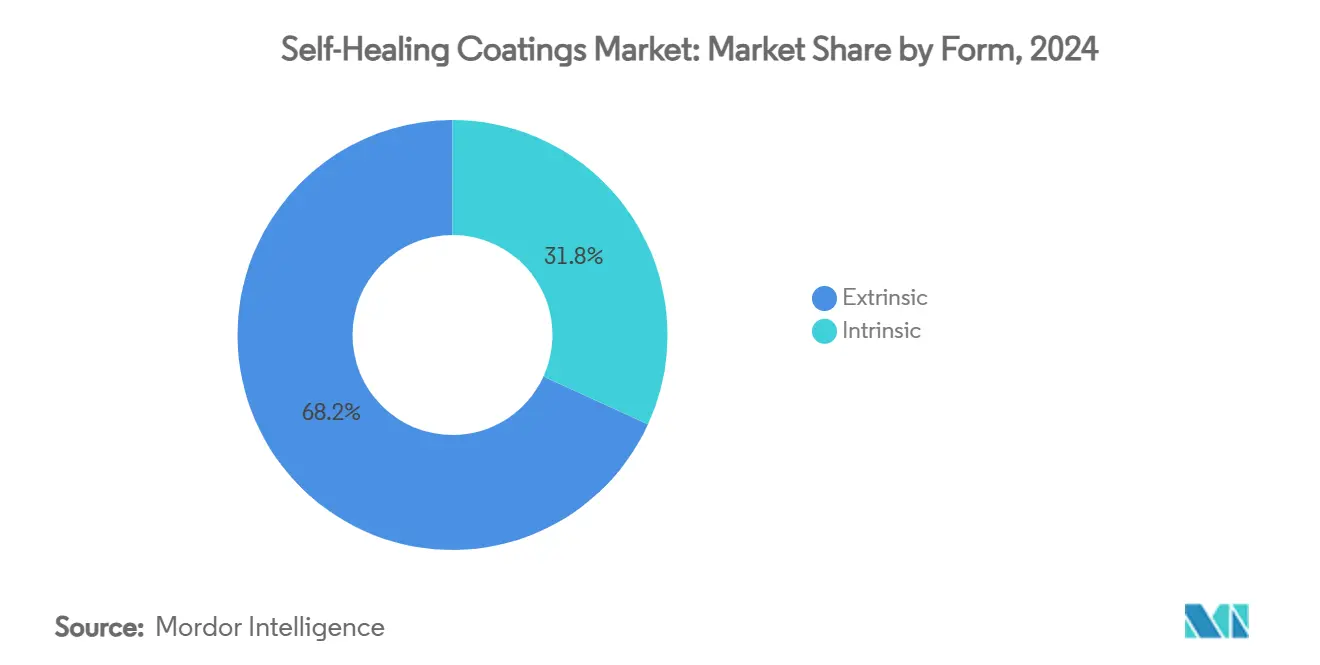
By Material Type: Polymers Dominate Innovation Landscape
Polymeric coatings hold 44.26% of global revenue, binding tightly to diverse substrates and supporting capsule dispersion without phase separation. They also register the steepest trajectory, advancing at a 21.38% CAGR, as polyurethane and epoxy matrices adapt to both encapsulated agents and reversible bonds. Bio-based polyurethanes formulated from renewable di-isocyanates are gaining traction in Europe to meet circular-economy directives, enlarging addressable volumes for the self-healing coatings market.
Metals and alloys remain niche, reserved for turbine blades and exhaust components facing 600 °C+ service, while ceramics and glass serve spacecraft thermal-barrier needs. Concrete and cementitious coatings are rising in prominence, particularly in Asia, as crystalline admixtures seal micro-cracks and counter chloride ingress, extending bridge deck life by up to 25 years. These specialty domains collectively enrich the material diversity and resilience of the self-healing coatings market size, even as polymers maintain center stage.
By End-User Industry: Construction Leads, Electronics Accelerates
Building and construction secured a 45.71% of the self-healing coatings market, driven by municipalities seeking long-lasting bridge, tunnel, and water-retention linings that minimize traffic closures and labor costs. Crystalline waterproofing mixtures enable concrete crack closure even under submerged conditions, cutting repair callouts by 60% on European canal locks.
Electrical and electronics, though presently under 10% of sales, is on course for the fastest ascent at 22.17% CAGR. Flexible printed circuits, foldable displays, and wearable sensors require coatings that restore conductivity after bending-induced micro-fractures; intrinsic self-healing polymers meet this need without adding bulk. Automotive follows closely, steered by EV warranty extensions and premium paint finishes, while marine and aerospace remain value-rich niches where performance trumps cost. Collectively, these shifts diversify revenue streams and anchor multi-industry resilience for the self-healing coatings market.
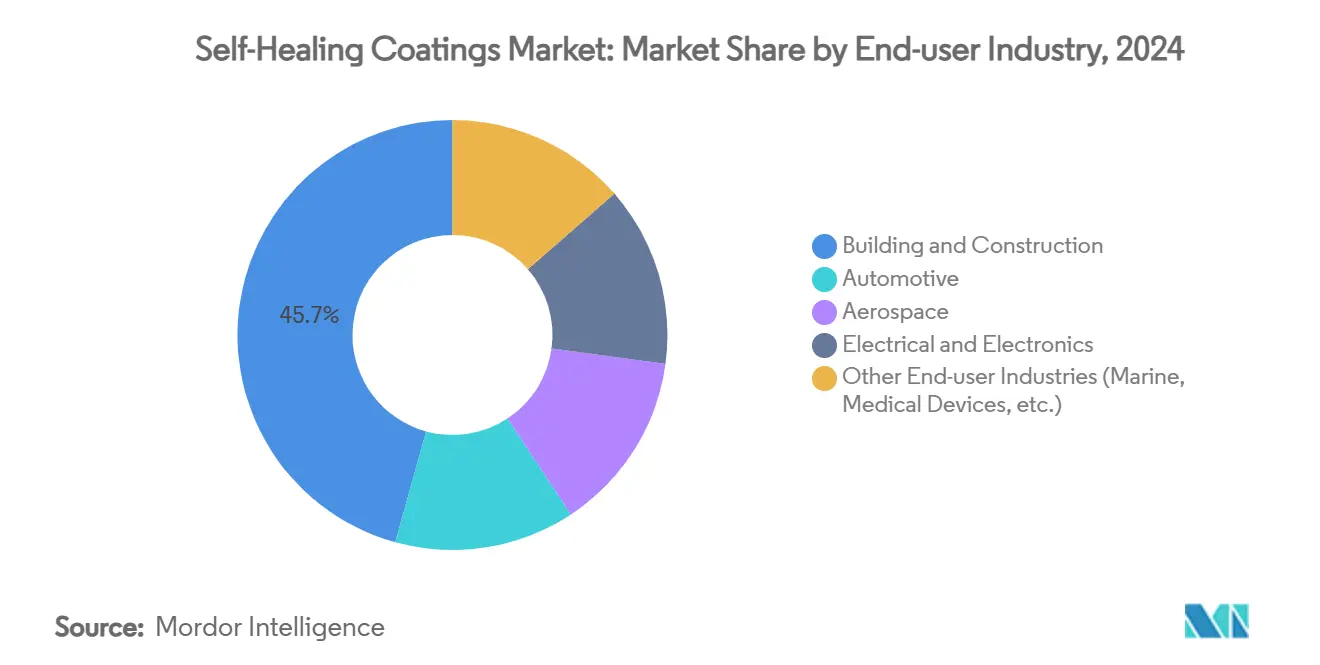
Note: Segment shares of all individual segments available upon report purchase
Geography Analysis
Europe led the self-healing coatings market in 2024 with 48.85% share, galvanized by the EU Green Deal’s sustainability targets and by robust public spending on bridge and rail asset renewal. German automakers’ accelerated EV rollout, coupled with Nordic shipowners’ early compliance with biofouling rules, sustained high-margin demand. Yet, regulatory permitting complexity and elevated labor expenses temper installation speeds relative to Asia.
Asia-Pacific is forecast to register a 24.59% CAGR as China, Japan, and India integrate self-healing coatings into smart-city, semiconductor, and port infrastructure agendas. Competitive manufacturing costs and faster approvals shorten go-to-market cycles, enabling regional suppliers to scale rapidly. Government stimulus under China’s Belt and Road Initiative is channeling funds toward long-lived, low-maintenance materials, further fueling demand in the self-healing coatings market size.
North America secures solid mid-teen growth anchored in aerospace, defense, and offshore wind assets, fields that prize high-endurance coatings and can absorb premium prices. The region’s technology convergence strengths, such as AI analytics, sensor integration, and additive manufacturing, give local vendors an edge in delivering data-driven coating-as-a-service models. Yet its mature infrastructure limits volume upside compared with the massive construction cycles underway in Asia and parts of the Middle-East.
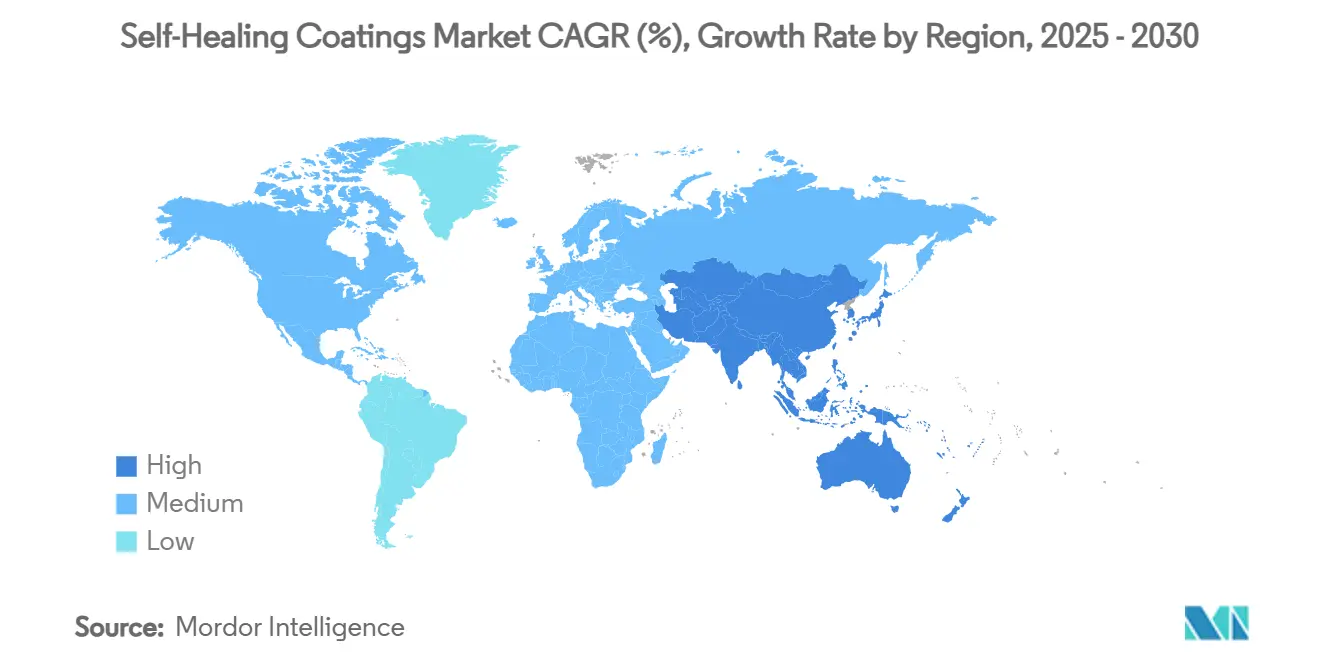
Competitive Landscape
The self-healing coatings market features a fragmented structure where innovation agility can outweigh sheer volume scale. Strategic partnerships are multiplying: European shipyards are co-developing self-healing antifoulants with coating suppliers to meet IMO guidelines; automotive OEMs are integrating suppliers into early design phases to tailor chemistries for specific EV architectures. Service-based business models are also gaining ground. Several North American vendors now guarantee coating performance over contract terms, bundling materials with continuous health monitoring and on-site analytics. Such shifts challenge traditional paint-sale economics and reward companies able to blend materials science, data services, and predictive maintenance to capture recurring revenue in the evolving self-healing coatings market.
Self-Healing Coatings Industry Leaders
-
Akzo Nobel N.V.
-
3M
-
BASF
-
PPG Industries Inc.
-
The Sherwin-Williams Company
- *Disclaimer: Major Players sorted in no particular order
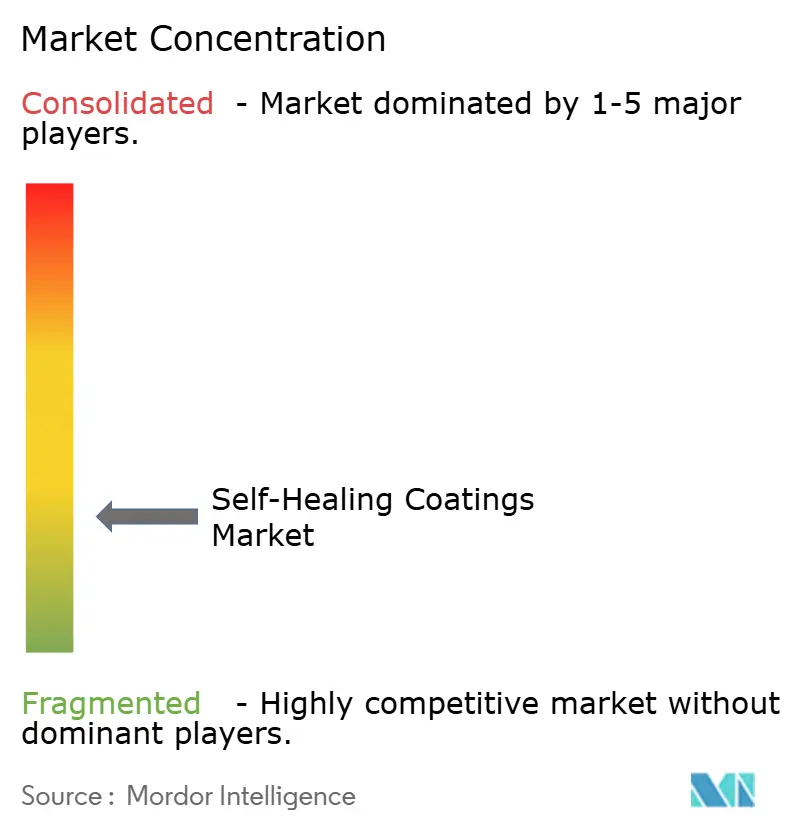
Recent Industry Developments
- October 2023: Akzo Nobel N.V. unveiled its latest innovation: the Interlux Self-Healing Antifouling Coating, designed specifically for marine applications.
- July 2023: Indian Institute of Technology Bhilai researchers unveiled a self-healing polymeric coating for photovoltaic modules, which demonstrates the ability to heal cracks spontaneously.
Global Self-Healing Coatings Market Report Scope
Self-healing coatings are the type of coatings that have the innate potential to mend suffered damage on their own or with an external stimulus.
The self-healing coatings market is segmented by form, end-user industry, and geography. By form, the market is segmented into extrinsic and intrinsic. By end-user industry, the market is segmented into building and construction, automotive, aerospace, electrical and electronics, and other end-user industries (marine, medical device, etc.). The report also covers the market size and forecasts for self-healing coatings in 27 countries across major regions. For each segment, market sizing and forecasts were made on the basis of value (USD).
| Extrinsic |
| Intrinsic |
| Polymers |
| Metals and Alloys |
| Concrete and Cementitious |
| Ceramics and Glass |
| Building and Construction |
| Automotive |
| Aerospace |
| Electrical and Electronics |
| Other End-user Industries (Marine, Medical Devices, etc.) |
| Asia-Pacific | China |
| Japan | |
| India | |
| South Korea | |
| Indonesia | |
| Vietnam | |
| Malaysia | |
| Thailand | |
| Rest of Asia-Pacific | |
| North America | United States |
| Canada | |
| Mexico | |
| Europe | Germany |
| United Kingdom | |
| France | |
| Italy | |
| Spain | |
| Nordic Countries | |
| Russia | |
| Turkey | |
| Rest of Europe | |
| South America | Brazil |
| Argentina | |
| Colombia | |
| Middle-East and Africa | Saudi Arabia |
| United Arab Emirates | |
| Qatar | |
| Egypt | |
| South Africa | |
| Nigeria | |
| Rest of Middle-East and Africa |
| By Form | Extrinsic | |
| Intrinsic | ||
| By Material Type | Polymers | |
| Metals and Alloys | ||
| Concrete and Cementitious | ||
| Ceramics and Glass | ||
| By End-user Industry | Building and Construction | |
| Automotive | ||
| Aerospace | ||
| Electrical and Electronics | ||
| Other End-user Industries (Marine, Medical Devices, etc.) | ||
| By Geography | Asia-Pacific | China |
| Japan | ||
| India | ||
| South Korea | ||
| Indonesia | ||
| Vietnam | ||
| Malaysia | ||
| Thailand | ||
| Rest of Asia-Pacific | ||
| North America | United States | |
| Canada | ||
| Mexico | ||
| Europe | Germany | |
| United Kingdom | ||
| France | ||
| Italy | ||
| Spain | ||
| Nordic Countries | ||
| Russia | ||
| Turkey | ||
| Rest of Europe | ||
| South America | Brazil | |
| Argentina | ||
| Colombia | ||
| Middle-East and Africa | Saudi Arabia | |
| United Arab Emirates | ||
| Qatar | ||
| Egypt | ||
| South Africa | ||
| Nigeria | ||
| Rest of Middle-East and Africa | ||
Key Questions Answered in the Report
What is driving the rapid growth of the self-healing coatings market?
Cost reductions in micro-capsule production, tighter environmental rules in Europe and the marine sector, and longer warranty demands from EV makers collectively push global demand upward, supporting a 20.91% CAGR to 2030.
Which end-use industry will grow fastest through 2030?
Electrical and electronics applications are projected to expand at a 22.17% CAGR as flexible circuits and IoT sensors require coatings that restore conductivity after mechanical stress.
Why are intrinsic self-healing systems gaining momentum?
Advances in dynamic covalent and supramolecular chemistries enable multiple repair cycles without depleting healing agents, driving a 21.13% CAGR for intrinsic formulations to 2030.
How do self-healing coatings support marine emission targets?
Autonomous antifouling layers maintain smooth hull surfaces, cutting fuel consumption up to 8% and helping ship owners comply with IMO 2023 biofouling guidelines.
What limits broader adoption despite clear technical benefits?
Current material costs remain 200-400% above legacy coatings, and complex aerospace qualification protocols can extend approval timelines to seven years.
Page last updated on:
